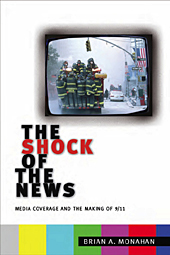AMES, Iowa -- Hear the numbers "9/11" and you immediately conjure up horrific images of New York's World Trade Center towers being struck by commercial jetliners, hijacked by terrorists. That's because the media devoted more resources to covering the 9/11 attacks than any other news event, and audiences were understandably riveted to that coverage for weeks.
But more than just the sheer volume of media attention, it was the way the tragedy was covered that gave the September 11 attacks iconic meaning and transformed "9/11" into a potent political symbol that continues to be used today, according to Iowa State University Assistant Professor of Sociology Brian Monahan. He examined mainstream media coverage of the attacks as a case study on how the news media create "public dramas" for a new book, "The Shock of the News: Media Coverage and the Making of 9/11" (March 2010, New York University Press), which went on sale last week.
"'9/11' has become a kind of symbolic shorthand," said Monahan, who also serves on the faculty of Iowa State's criminal justice program."If someone says '9/11' in relation to matters of domestic policy, social control or foreign affairs, the audience can immediately draw on our shared understanding of 9/11 and we know what they are talking about is serious and demands our attention and concern. This obviously makes 9/11 a valuable resource for elected officials and other public figures who look to gain support for a particular policy or agenda by creating a linkage to 9/11."
The making of a "public drama"
Monahan defines a "public drama" as a particular format used by the news media to organize and present news in the form of highly dramatic and emotional stories that offer a mixture of compelling characters, dynamic plot, captivating settings and other story elements. Through the book's 9/11-specific content, he advances a public drama framework as a way to understand why so much contemporary news takes the form of serialized dramas that often bear greater resemblance to popular fiction than detached journalistic inquiry.
The key component in creating a public drama, according to Monahan, is piecing the various news elements -- information, events, images, quotes, timelines and so on -- into a compelling story.
"Making a public drama requires more than just grizzly details or human interest," he said. "It's got to be a story with suspense and intrigue and plot developments and characters fully developed.
"The audience has to care about what is being presented; they need to feel an emotional or psychological connection with the plot or the characters," he continued. "So it's not quite just as voyeuristic as simple human interest would imply. It's more immersive."
Before he could assess if that's the way the 9/11 tale was told and retold, Monahan first had to determine how best to analyze the massive media coverage the tragedy received.
"I'd say the two challenges [in writing the book] were one, making sense of history as it was unfolding; and two, digging in to the most covered event in the media age and finding a representative way to go through that," Monahan said. "And essentially, I turned to previous research on most major events and found that people turn to television first. Eventually, television can only offer so much depth to the coverage -- whether it be for time, narrative or format constraints -- and so people turn to other sources; in this case, print and online news articles."
Studying "Today," The New York Times
Because of how the public gets news in major events, Monahan chose to analyze the first week of television coverage on NBC's "Today" show -- the highest rated morning show on the most watched news network at the time. He also chose to review the first year's coverage from The New York Times because it provided the most comprehensive coverage of 9/11 and is still largely regarded as the nation's "newspaper of record."
The book details how the 9/11 coverage was transformed from initial hard news to what Monahan calls a morality-based tale centered on patriotism, victimization and heroes.
But while news presented as a public drama may make for captivating television or interesting reading, Monahan says it often results in an incomplete understanding of events and issues.
"The emphasis on creating an entertaining story with a titillating plot requires an unfortunate trade-off in which a balanced assessment of the policy implications of an issue, or the causes or consequences of an event often gets cast aside in favor of a non-complex narrative that will appeal to the audience," he said. "As a result, the public ends up with an overly simplistic and often skewed understanding of what has happened, why it has happened and what should be done in response."
Because of the frequency in which the powerful public drama format is used, Monahan encourages everyone to become more critical consumers of news -- particularly when the story's script takes on an iconic life of its own.
The book is available for purchase online at its Web site at www.theshockofthenews.com, or on Amazon.com.
